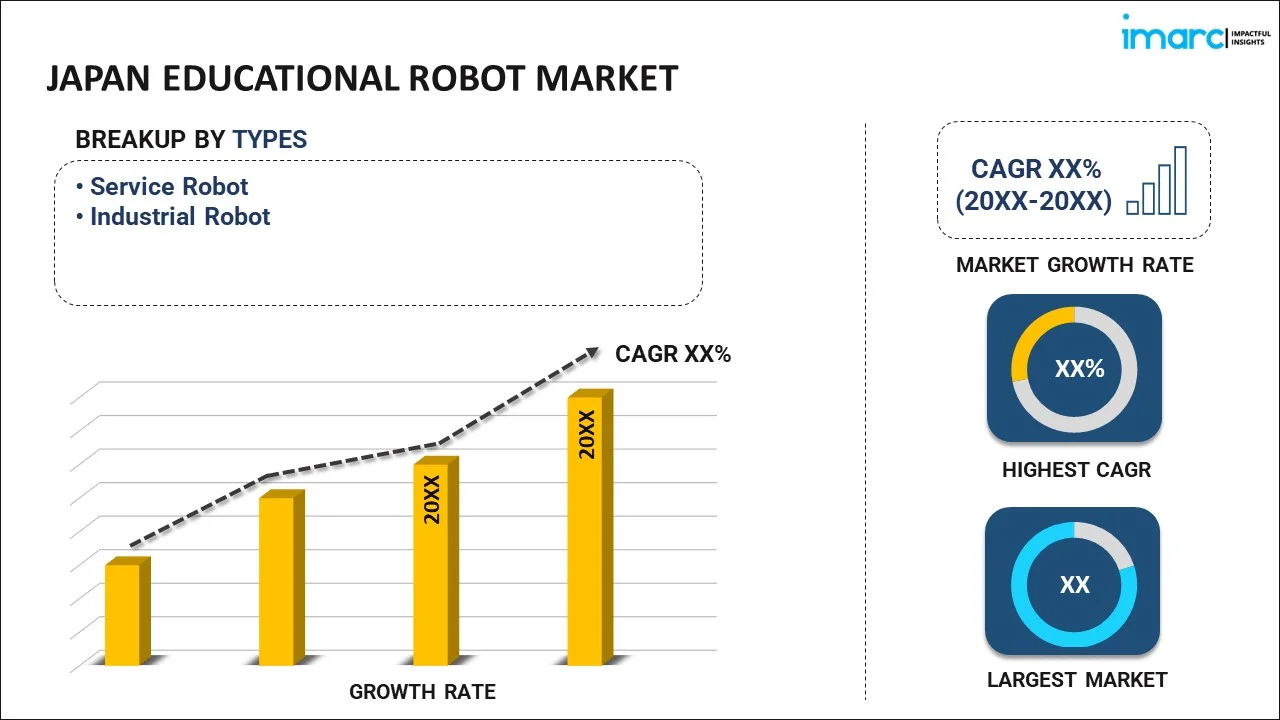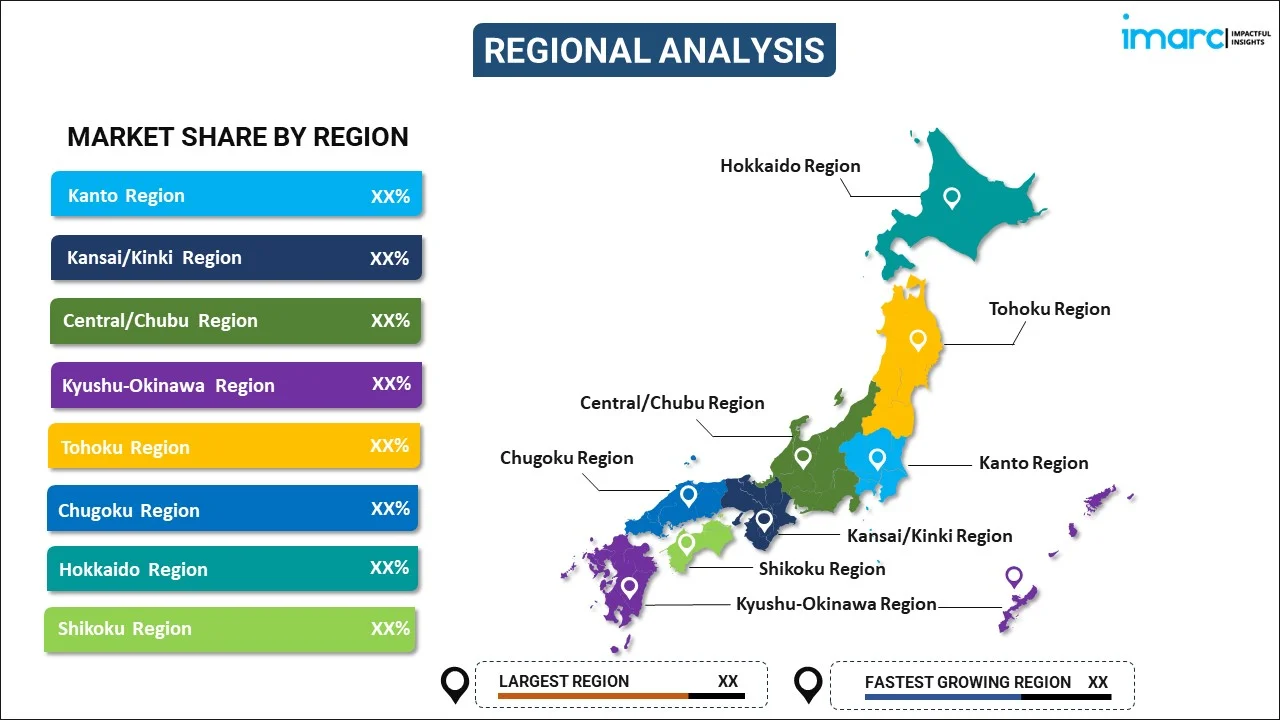
Japan Educational Robot Market Report by Type (Service Robot, Industrial Robot), Component (Hardware, Software), End User (Primary Education, Secondary Education, Higher Education, and Others), and Region 2026-2034
Market Overview:
Japan educational robot market size reached USD 142.6 Million in 2025. Looking forward, IMARC Group expects the market to reach USD 515.5 Million by 2034, exhibiting a growth rate (CAGR) of 15.35% during 2026-2034. The growing popularity of e-learning methods, along with the rising usage of advanced technologies in the education sector, is primarily driving the market growth.
|
Report Attribute
|
Key Statistics
|
|---|---|
|
Base Year
|
2025 |
|
Forecast Years
|
2026-2034
|
|
Historical Years
|
2020-2025
|
| Market Size in 2025 | USD 142.6 Million |
| Market Forecast in 2034 | USD 515.5 Million |
| Market Growth Rate (2026-2034) | 15.35% |
An educational robot serves as an educational aid, employing realistic educational simulations to facilitate the acquisition of skills in individuals spanning various age groups. It provides educational content spanning a wide spectrum, encompassing subjects like science, technology, engineering, art, and mathematics (STEAM), as well as applied mathematics, computer programming, linguistics, and subjects like history and geography. These robots are multifunctional, employing gestures, voice control, and advanced mechanics to captivate, entertain, and educate students effectively. Collaborating with these educational robots has demonstrated tangible benefits, leading to enhanced creative problem-solving abilities, improved communication skills, and the development of stronger interpersonal skills among students. Consequently, these robots are extensively utilized in educational settings, including special education institutions, primary and secondary schools, as well as institutions of higher education.
Japan Educational Robot Market Trends:
In the context of the Japanese market, the market's growth is being propelled by several significant factors. One of the primary drivers is the burgeoning trend of digitization, coupled with the escalating use of artificial intelligence and machine learning (AI/ML) technologies within the education sector. Educational robots, renowned for their effective interactive capabilities, are swiftly gaining acceptance in K-5 and K-12 schools as well as other educational institutions across Japan. Moreover, the widespread adoption of e-learning methodologies, which encompass the use of teaching robots, digital whiteboards, and flipped classrooms, is offering a highly advantageous approach to disseminating knowledge, contributing significantly to market expansion. Furthermore, continuous technological advancements have led to the development of advanced educational robot variants, equipped with autonomous navigation and environmental sensors capable of detecting obstacles in their surroundings. These innovations have rendered these robots more user-friendly and have substantially improved their overall operational efficiency. Additional factors, including substantial investments in the education sector by both government entities and non-government organizations (NGOs), extensive research and development (R&D) activities in the realm of robotics, and the availability of affordable educational robots, are anticipated to further propel market growth within Japan over the forecasted period.
Japan Educational Robot Market Segmentation:
IMARC Group provides an analysis of the key trends in each segment of the market, along with forecasts at the country level for 2026-2034. Our report has categorized the market based on type, component, and end user.
Type Insights:

- Service Robot
- Humanoid
- Non-Humanoid
- Industrial Robot
The report has provided a detailed breakup and analysis of the market based on the type. This includes service robot (humanoid and non-humanoid) and industrial robot.
Component Insights:
- Hardware
- Robotics Arms
- Controllers
- Sensors
- Power Source System
- Others
- Software
A detailed breakup and analysis of the market based on the component have also been provided in the report. This includes hardware (robotics arms, controllers, sensors, power source system, and others) and software.
End User Insights:
- Primary Education
- Secondary Education
- Higher Education
- Others
The report has provided a detailed breakup and analysis of the market based on the end user. This includes primary education, secondary education, higher education, and others.
Regional Insights:

- Kanto Region
- Kansai/Kinki Region
- Central/ Chubu Region
- Kyushu-Okinawa Region
- Tohoku Region
- Chugoku Region
- Hokkaido Region
- Shikoku Region
The report has also provided a comprehensive analysis of all the major regional markets, which include Kanto Region, Kansai/Kinki Region, Central/ Chubu Region, Kyushu-Okinawa Region, Tohoku Region, Chugoku Region, Hokkaido Region, and Shikoku Region.
Competitive Landscape:
The market research report has also provided a comprehensive analysis of the competitive landscape. Competitive analysis such as market structure, key player positioning, top winning strategies, competitive dashboard, and company evaluation quadrant has been covered in the report. Also, detailed profiles of all major companies have been provided.
Japan Educational Robot Market Report Coverage:
| Report Features | Details |
|---|---|
| Base Year of the Analysis | 2025 |
| Historical Period | 2020-2025 |
| Forecast Period | 2026-2034 |
| Units | Million USD |
| Scope of the Report | Exploration of Historical and Forecast Trends, Industry Catalysts and Challenges, Segment-Wise Historical and Predictive Market Assessment:
|
| Types Covered |
|
| Components Covered |
|
| End Users Covered | Primary Education, Secondary Education, Higher Education, Others |
| Regions Covered | Kanto Region, Kansai/Kinki Region, Central/ Chubu Region, Kyushu-Okinawa Region, Tohoku Region, Chugoku Region, Hokkaido Region, Shikoku Region |
| Customization Scope | 10% Free Customization |
| Post-Sale Analyst Support | 10-12 Weeks |
| Delivery Format | PDF and Excel through Email (We can also provide the editable version of the report in PPT/Word format on special request) |
Key Questions Answered in This Report:
- How has the Japan educational robot market performed so far and how will it perform in the coming years?
- What has been the impact of COVID-19 on the Japan educational robot market?
- What is the breakup of the Japan educational robot market on the basis of type?
- What is the breakup of the Japan educational robot market on the basis of component?
- What is the breakup of the Japan educational robot market on the basis of end user?
- What are the various stages in the value chain of the Japan educational robot market?
- What are the key driving factors and challenges in the Japan educational robot?
- What is the structure of the Japan educational robot market and who are the key players?
- What is the degree of competition in the Japan educational robot market?
Key Benefits for Stakeholders:
- IMARC’s industry report offers a comprehensive quantitative analysis of various market segments, historical and current market trends, market forecasts, and dynamics of the Japan educational robot market from 2020-2034.
- The research report provides the latest information on the market drivers, challenges, and opportunities in the Japan educational robot market.
- Porter's five forces analysis assist stakeholders in assessing the impact of new entrants, competitive rivalry, supplier power, buyer power, and the threat of substitution. It helps stakeholders to analyze the level of competition within the Japan educational robot industry and its attractiveness.
- Competitive landscape allows stakeholders to understand their competitive environment and provides an insight into the current positions of key players in the market.
Need more help?
- Speak to our experienced analysts for insights on the current market scenarios.
- Include additional segments and countries to customize the report as per your requirement.
- Gain an unparalleled competitive advantage in your domain by understanding how to utilize the report and positively impacting your operations and revenue.
- For further assistance, please connect with our analysts.
 Request Customization
Request Customization
 Speak to an Analyst
Speak to an Analyst
 Request Brochure
Request Brochure
 Inquire Before Buying
Inquire Before Buying




.webp)




.webp)












